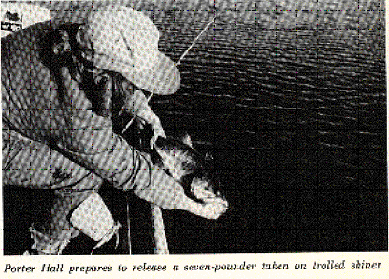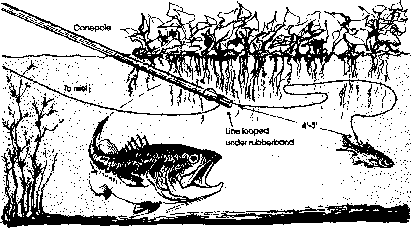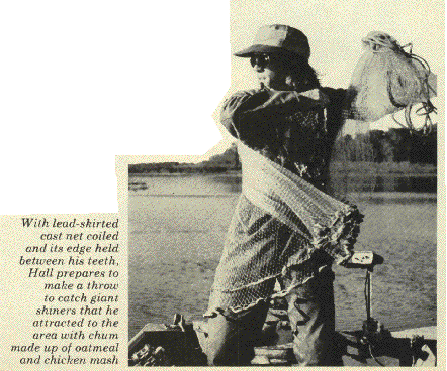| The Outdoorsmen | home |
| Catch The Lunker Of Your Life | Catch The Lunker Of Your Life | Catch Bass Anytime | Fast Trolling For Muskie | Wild Wonderful Whitefish |
| Catch The Lunker Of Your Life |
sees just before he falls asleep after a day of watching the flocks trading darkly against a winter sky.
Pile up the mornings, days, and nights you spend looking to break a personal largemouth record, and, like as not, in the final instant before sleep you will twitch awake in the terrible knowledge of having missed the great strike that would have set you free from your nerve-rasping quest. Bigness in bass is a relative thing, depending on where you live or how you earn your keep.The five-pound mark is big, all
right, and something to shoot for in the North Country. No one puts down a seven-pounder elsewhere, including the South, and an angling milestone for all but the most jaded is a 10-pounder. Beyond that, maybe you aim to break the 22-pound 4-ounce world record set in Georgia by George Perry in 1932.
There's a lot of speculation going on about where that new world-record bass is lurking.
Guesses run from farm ponds in Perry's home state to California's Miramar. Sly smiles and rubbed
palms are seen these days in Texas, and there are boosters of Mexico's Lake Vicente Guerrero
and Honduras's Lake Yojoa. Friends with whom I like to shoot clay pigeons yearn for the day when Fidel Castro gives the nod to Yank sportsmen so they can make for legendary Treasure Lake, in which, they insist, swims a 30-pounder. And the next world record just may come from Florida, whose native largemouths are the same subspecies as those fish growing to marvelous proportions in the trophy-bass hotspots just mentioned.
I do not have so burdensome a grail to reach as the No. 1 bigmouth. Bass of more modest size
are big by my definition. If you asked me to pick one place for consistent catches of bucketmouths of, say, eight pounds up into the teens, I'd pick central Florida, the area roughly between Jacksonville and Orlando.
I believe that the average fisherman has a greater chance to take more big bass out of small to medium-size lakes even ponds than he does in the deep man-made reservoirs. Certainly there are big fish in the deeper impoundments, but in small fertile lakes, wherever they are located around the country, you'll be bringing your bait or lure past the lunkers for a greater percentage of time than you would where the fish have recourse to great depths.
Bass don't grow as large in Yankee country as they do in Florida, but the methods for taking the biggest largemouths from the smaller waters both North and South are similar. Big bass have things in common
wherever they are. Many of their year-class mates are no longer living. Except during spawning season, if they have no size equals they will frequently lurk on the fringes of the local bass community composed of somewhat smaller fish. With others of comparable dimensions nearby,they will school loosely. When the time comes to take cover, the biggest fish will take the prime shelter-the spots farthest back in a hole, the thickest cover into which they can squeeze. This is one reason anglers are usually presenting their baits or lures to the smaller fish first. There are just fewer of the larger bass around, so you will have to fish longer and harder to catch them.
The larger fish will definitely pursue baits or lures, but generally not with the same frequency or gusto as their smaller brothers. They are cautious and seem to find bright light even more offensive than
the smaller fish do.
Because of all these things, Ibelieve that a great percentage of trophy-size largemouths are caught on natural bait and easy swimming subsurface lures by day in spring and fall, and on noise-making lures at night in the summer.
Two men I know agree with that premise and have taken it several steps further. They have so refined their techniques that they are able to earn their livings by guiding anglers exclusively to giant
largemouths Their catches are made with two natural baits and a couple of lures.
John D. McClanahan and his partner Porter Hall run a guiding service known as Trophy Bass Unlimited. Their aim is to get each angler they guide into huge fish, shooting for at least the 10-pound mark, but sometimes having to be satisfied with eight and nine-pounders. The two anglers have picked a good area
in which to achieve their difficult goals: the heart of the central Florida lake country around Citra, Orange Springs, and the Ocala National Forest.
McClanahan and Hall are the antithesis of the tournament fisherman, though they were introduced to me by a top tournament angler and mutual friend, Billy Westmorland. The tourney fisherman's goal, total catch weight, is usually achieved by numbers of medium and small fish. But the fellows from Trophy
Bass put in many hours for maybe only one fish. But that fish will be something to write home
about. John and Porter work out of boats matched to small water the back-in-and-under spots they
fish. McClanahan operates from a low-slung 15-foot 8-inch custom wood hull he designed and built with some help from designer Myron Warr. Porter uses a 15-foot Fisher Marine aluminum johnboat. For their style of fishing, the most important accessories aboard, excluding tackle, are the heavy-duty Down East
rod holders from Yarmouth, Maine, and an electric trolling
motor. With countless small-to-medium-size lakes and potholes in the area they fish, these lunkerhunters have, through careful analysis, pinpointed the waters most likely to give up the greatest number of large fish. They avoid the clearest waters and those that are black with excessive tannic acid. The finest waters have some color and are rich with wildlife above the surface as well as below. Eagles, cormorants, and water turkeys in the vicinity, along with turtles and a good supply of large shiners in the water, indicate a probable good population of big bass.
In the absence of classic deep water structure, the trophy bass men look for such concentration areas as troughs out in midlake, bars with substantial weed growth, and beds of vegetation, including lily pads, that extend from the banks out into the lake. The precise targets in these general areas include cuts or
depressions in weed lines or beds changes of depth of only one or two feet. The lakes are only eight to about 15 feet deep.
Early in the season John and Porter fish for bass in prespawning or postspawning condition, not for fish on their beds. Their methods can be used by anglers seeking trophy bass elsewhere in similar small lakes, or bays in larger ones. In the North, how- ever, the bait should be slightly smaller.
The first time I saw Porter Hall collect shiners, the prime bait for the spring fishing, I was impressed by his technique. He sweetened the shallows with oatmeal and chicken egg-laying mash, coiled his lead-skirted cast net, and threw it out, being careful to release the edge held between his two front teeth in order to avoid losing those teeth. Porter hauled in, and a wealth of large golden shiners tumbled from the nylon. I picked some up."What do we do, eat these for lunch?" I asked. "Fish with 'em," he said.
I measured one of the minnows. The tape read 11 inches. "Good grief! At home we don't use anything larger than four inches," I said. "How big are your bass?" "How big are yours?" "You'll see," he said. To reel Stop swivel Torpedo-shaped float Swivel or yarn stop


| Above: rig for stillfishing shiners in shallow |
| water. Left: Model 84 Eagle Claw hook with |
| shank bent; hooks are honed needle-sharp. |
| Below: shiner stillfishing rig for deeper water |
| Torpedo-shaped sliding float/ Stop swivel_? /weights |

| Porter Hall prepares to release a seven-pounder taken on trolled shiner |

Canepole rig for pushing shiner under beds of floating hyacinth. When a
bass strikes, line pulls free of pole and fish is fought with casting rod
The trophy hunters have two main systems for the early shiner fishing trolling, and stillfishing
with bobbers. Dull? Not on your life. Try to relax and enjoy thesun with these techniques, and you're wiped out before you begin.
The rods-heavy S-to-SYz-footers on Fenwick and Lamiglass blanks, and tough enough to handle big chinook salmon are placed in the quick release rod holders. The reels are Ambassadeur 6500C's with the
tension spring on the click reworked so that when the reel is in free-spool the shiners can just move along behind without taking line out. The lightest additional pressure pulls line from the reel. The reels are loaded with 30-pound-test monofilament that has an indelible mark 45 feet from the hook.
Hooks are mainly No. 3/0 to 8/0 Model 84 Wright & McGill Eagle Claws with the eye and first half-inch of shank bent at a 45° angle toward the point.
The line of pull with a good snell causes the point to dig in past the barb and then curve toward the angler. It is effective.
The big shiners are hooked through the bottom lip to one side and up out the nostril on the opposite side, or directly up through both lips. Two small rubber or plastic discs of the size used to hold trailer hooks on lures go on the hook bend, one below the minnow's lips, the other above. These discs keep the
bait in place on the hook bend. The lower disc helps prevent the hook, once it is in a bass's mouth, from coming around and hooking only the minnow on the strike. The shiner, which may be fin-clipped for more erratic action, is trolled 100 to 140 feet behind the boat.
Trolling is done with the electric motor at medium to low speed, depending on the breeze.Too much wind prevents effective trolling. All the weed lines are tried, plus the slots, humps,bars, and flats. There is no casual lean-back-and-open-a-bottle-of-pop time. You must be constantly alert to what the baits are doing. A sudden spurt of action by the bait usually indicates the approach of a bass and is your signal to stand by.I sometimes use a shallow or medium-depth swimming plug on one rod and a minnow on
another, but John and Porter stick with the big shiners."You don't touch the rod even though a shiner seems to be going crazy," Porter told me one day as we worked a seven-acre lake.
An especially active minnow can occasionally tug hard enough to activate the click, and if this becomes a problem the mechanical brake on the left side of the reel can be slightly tightened.
Suddenly the reel on the port side began to purr. Porter quickly reached forward and snapped off the click, putting the reel totally into free-spool. He turned the boat toward the place where the line
disappeared into the water."Click off first before anything," Porter said. "Then you gently take the rod from the holder without touching the spool." He did that, and pointed the rod toward the fish. The line
was still going out."Now you've got to get in to him," Porter said.
He cranked the reel into gear and took up the slack. Then he depressed the free-spool button again. I looked at my watch.The line started going out again, and he let it go. Using the electric in low, he gained on the fish,picked up slack, then went back into free-spool."Got to get to that mark on the line before striking him," he said. "If we strike when we're With lead-skirtedast net coiled and its edge held between his teeth,Hall prepares to make a throw to catch giant shiners that he attracted to the area with chum made up of oatmeal and chicken mash farther away than that, we lose too many fish because of the line stretch."
This is some cool operator, I thought, giving me a running commentary when who knows what is on the end of that line. Ever so slowly the mark came up and into the guides. I saw that now even Porter's hands
were trembling slightly. Good he's human too, I thought, my throat dry. According to my watch, 4V2 minutes of this give and take had passed."When you strike, you really hit him," Porter whispered, "and
you keep your rod tip up and never let it down. Now ..."
He brought the rod slowly up to a 45° angle from the horizontal, where it had been held to let line
out with no resistance. Then he lowered it again to the horizontal, cranking up the last inch of slack against the feel of the bass. And then he came back, hard, whaling the hook home with everything he had, the heavy rod going over in a perfect letter U, and Porter grunting from the effort only once. Forty-five feet
out off the port quarter the big largemouth came up, went down, then broke the surface in a heavy,
wallowing jump. Porter grinned. The water churned frothy white in the sun and he brought the bass in carefully after it made two more jumps.

I netted the fish, and when Porter lifted the big-bellied largemouth he sighed. "Shucks, he's just a little feller."
The scales read seven pounds. We took the hook from the fish's mouth and released him. "I'm a believer," I told him. "And this technique is very difficult on a person's nerves." "I know," Porter said. "Do you use other baits?" "Yes, a little later in spring the sirens hatch and we net them. They're
best worked back in the little coves and pockets."
Sirens are eellike salamanders with two front legs, common in Florida and parts of Georgia. They grow to
12 or 14 inches long. "We screen them by wading in the pads and hyacinths," Porter said. "We also catch shrimp, turtles, frogs, and water snakes doing that." "You stillfish the sirens like you can do with these giant shiners?" I asked."Yes." "Let's use the shiners."
After I caught some fish by trolling,Porter demonstrated the stillfishing techniques he and John have developed for lunker largemouths. Many of them are similar to the free-drifting-minnow techniques used in the North, but again the giant baitfish and special hook are used. The rods for stillfishing are stiffer seven foot models that give the angler considerable leverage and enable him to cast the heavy minnow plus the torpedo shaped bobber (used because it tends to slip through the weeds better if a shiner or bass takes it there).
As Porter indicated, however, the big bass rarely make for the shallow-water cover when hooked, preferring to head for deeper water. This knowledge is critical in boat placement and in being alerted to the probable course of a hooked bass.
Shiners for stillfishing are hooked just to the rear of the dorsal fin without touching the backbone, which would kill the bait. A sliding-bobber rig is used when there must be six or more feet between float and bait. This rig is employed when fishing over bottom vegetation or troughs in open water. A little weight is used in these situations to help take the big shiner down. In most of the stillfishing the bait rides only two or three feet below the float, and the fishing is done close up against shore vegetation.
You can, to a degree, manipulate the shiners by putting a little pressure on them with the rod. They tend to run away from the pressure as soon as it is relaxed. You lob theshiner close to the shore weeds. Soon he will begin negotiating along the edge of the vegetation. Don't let him run back too far beneath the weeds, or he'll get tangled in the root network. It is important to keep your eye on the bobber at all times. A big bass will lumber close, and the shiner will begin to worry. The bobber will begin making frantic darts. Do nothing. Only when the float disappears do you go into action.
Make sure your reel is in free-spool. Let the bass run with the shiner, keeping only the slightest drag on the spool with your thumb to prevent overrun. The bobber may pop up again. Let it rest. Usually the bass
will come back for a second go around. Evidently during the first run something bothered him, possibly the
resistance from the float.
The important thing is to let the largemouth run with the shiner. When he has stopped, wait a few more seconds, crank up all slack against him, then hit hard. Sometimes when you're anchored you will be forced to haul in and follow a running bass. In this form of fishing, as in the trolling method, make sure to use your electric motor to avoid casting the shadow of the boat, rod, or angler over the fish's position. Doing so is often enough to make him drop the bait.
A third form of lunker fishing may appeal to you if you intend to fish some of the slow-moving rivers in the South or larger lakes choked along the shoreline with hyacinths. The method is deadly when free-floating islands of hyacinths are present.
It involves using a cane or fiberglass pole 11 to 15 feet long to insert your shiner beneath floating blankets of the plant.
In the McClanahan-Hall method which has proved itself on the Okiawaha River and others-you make a
loop in your fishing line four to five feet above the bait and slip the loop beneath a rubberband around the end of the pole. The pole and following baitfish can be poked into different positions beneath the weedbeds.
When a bass engulfs the bait, the line pulls free of the pole, and you fight the fish on rod and reel in the normal way. Whether drifting or at anchor, you must avoid making any boat noise while using this
technique.
As the season progresses, John and Porter begin relying on black, blue, and purple worms in the 10-inch size for fishing the smaller lakes. These worms are fished in the normal way, but a shiner is still generally used on one rod. Other top anglers I know go to the big 13-inch Hawg Hunter worms, and leadhead jigs trimmed with worms or plastic eels.
Tips For Trophy Largemouth Hunters __
• When scouting for lakes likely to harbor big largemouths, look for fertile
smaller waters that are subject to wa-ter-level fluctuations. A lake in which
natural fluctuations have been destroyed by dams or other control devices
begins to stagnate. Natural periods of high water give bass a chance to roam
flooded banks where nutrients are released and baits congregate. Such
forays give the bass a chance to put on a lot of weight. Dead trees or brush
along shore indicate past high-water periods.
• Try to make friends with caretakrs or residents of private lake
communities. You may come up with a nearly private lunker hole.
• Pick lakes with large numbers of big forage fish. By exploring the
shallows at night with a high-intensity light you can often locate and
note the size of the minnow life. Use minnow traps or minnow nets where
legal. Otherwise angle for minnows with tiny grubs, breadballs, or meal
mash and thin small hooks.
• The largest bass usually pick the choicest cover. Get your lures or bait
back in or far under the heavy cover. Don't waste time on marginal areas.
• Fish slowly and deliberately.
These lures are effective when higher light levels push the bigger fish deeper and far beneath overhanging vegetation.
They can be worked slowly, tantalizingly, with hops and up-and-down fluttering action at the doorway to
good-looking bass holes, along breaks in shore weedlines, and in slots in
open water of the small lakes.
In the heart of summer John and Porter begin relying on the fourth technique in their quartet of lunker-
hunting methods. They do most of their fishing at night with one lure, the big I1/4-ounce muskellunge-size
Jitterbug. They use primarily one color: black. The secret in working this plug for giant bass is to avoid all
fancy twitching action. Simply cast it along weedlines and points, and begin a slow, steady retrieve that brings forth a rhythmic plop-plop sound. Bass usually can hear this seductive sound
from far away.
Specialists devoted to this lunker Jitterbugging have learned how to fine-tune their plugs by bending the
cupped lip so that it scoops more water and produces a different sound.
Old-timers insist that the wood Jitterbugs, no longer made commercially, were even more effective than the plastic ones. The wood plugs were often bob-tailed by cutting off one-
fourth to one-half inch at the end.The rear treble-hook mount was then replaced with a screw eye, and one of the barbs on the rear treble was clipped off to make the plug less prone to picking up weeds. This
shortening gave the lure a somewhat faster side-to-side wobble, making it all the more irresistible to curious lunkers.
Big fish often miss the plug when they strike at night. If one does, and you have the nerve control, stop your Jitterbug for a couple of moments, then begin that controlled plop-plopping retrieve. The fish is very likely to be hovering in the area and may well charge again right at the boat.You get an eight or 10-pounder doing things like crushing a surface plug right under your nose, and there will be some excitement, I can guarantee you that.
Heavy casting tackle is the proper gear in these situations. If you should hook a fish, your partner can often nail another good one by casting outjust beyond where your hooked lunker is struggling.

John McClanahan shows 11-pounder
This ploy should be used only by the best of friends, because sometimes lines tangle and fish are lost.
I asked John McClanahan what he thought his chances were for breaking the current world record.
There was no hesitancy in his reply. "Oh, we'll break it," he said. "Either Porter or I. It's only a matter of
time."
•Anglers visiting Southern waters who want to fish with giant shiners but don't want to net them may have a hard time getting them. Bait dealers rarely keep the large size. One suggestion is to try catching your own shiners by seeding the shallows with oatmeal or other mash, then dropping a small plastic grub on a No. 12 hook amid the chum. An aerator and live well are needed to keep the shiners
healthy.
For more information on Trophy Bass Unlimited, write John McClanahan (OL), P.O. Box 173, Orange
Springs, FL 32682. McClanahan also offers maps of top lakes and hotspots for $10.
But before you hit the super-lunker water, try some of these techniques
in your own small fertile lakes near home. Or, if you live near a reservoir,
go out some day and give these methods a try. You are likely to get
your biggest bass ever or at least the biggest you've ever caught in your region.
OUTDOOR LIFE MAY 1976